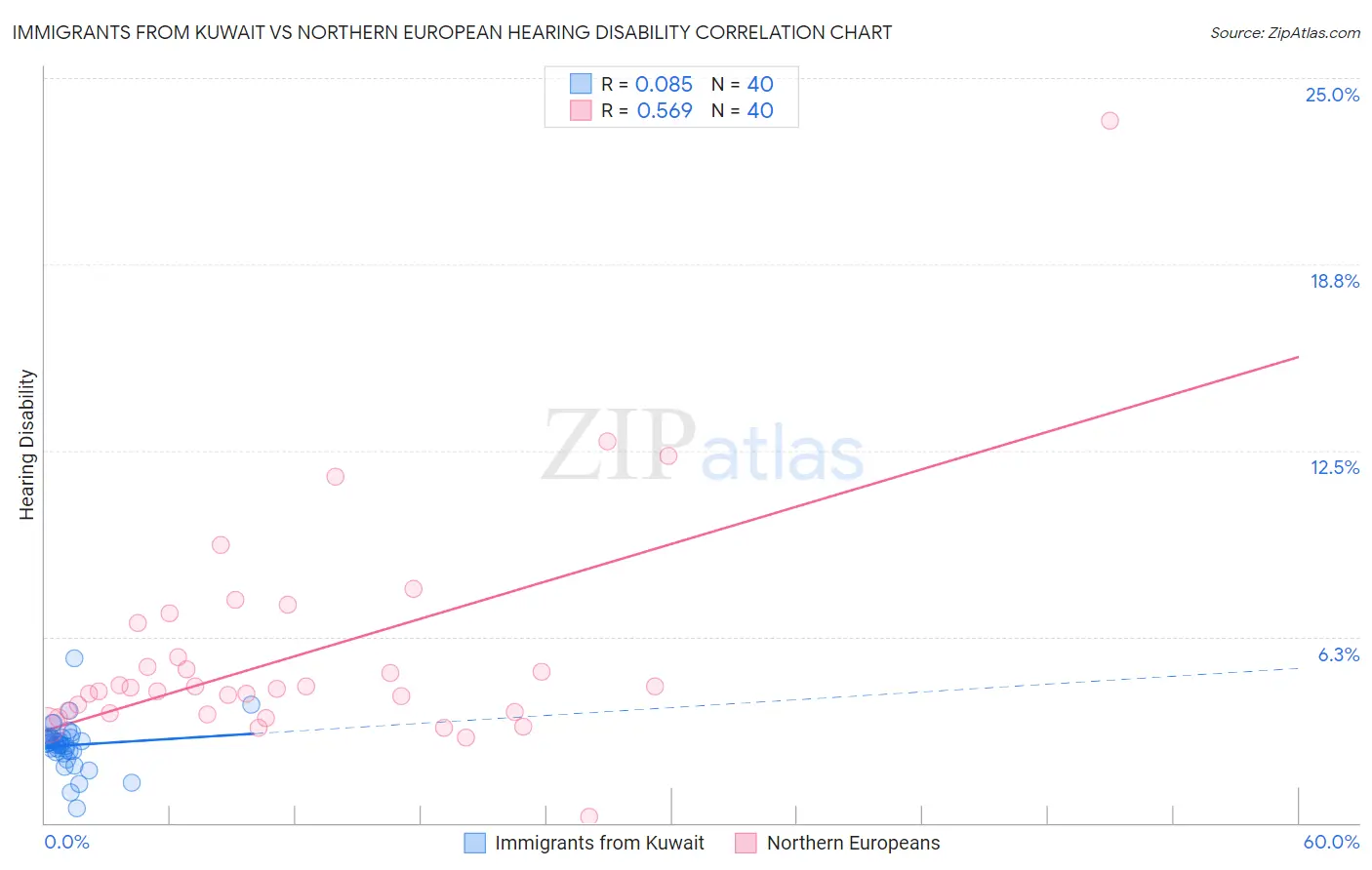Immigrants from Kuwait vs Northern European Hearing Disability
COMPARE
Immigrants from Kuwait
Northern European
Hearing Disability
Hearing Disability Comparison
Immigrants from Kuwait
Northern Europeans
2.8%
HEARING DISABILITY
96.3/ 100
METRIC RATING
93rd/ 347
METRIC RANK
3.4%
HEARING DISABILITY
0.2/ 100
METRIC RATING
258th/ 347
METRIC RANK
Immigrants from Kuwait vs Northern European Hearing Disability Correlation Chart
The statistical analysis conducted on geographies consisting of 136,905,623 people shows a slight positive correlation between the proportion of Immigrants from Kuwait and percentage of population with hearing disability in the United States with a correlation coefficient (R) of 0.085 and weighted average of 2.8%. Similarly, the statistical analysis conducted on geographies consisting of 405,970,719 people shows a substantial positive correlation between the proportion of Northern Europeans and percentage of population with hearing disability in the United States with a correlation coefficient (R) of 0.569 and weighted average of 3.4%, a difference of 24.6%.

Hearing Disability Correlation Summary
| Measurement | Immigrants from Kuwait | Northern European |
| Minimum | 0.48% | 0.22% |
| Maximum | 5.5% | 23.6% |
| Range | 5.0% | 23.4% |
| Mean | 2.6% | 5.7% |
| Median | 2.7% | 4.5% |
| Interquartile 25% (IQ1) | 2.4% | 3.7% |
| Interquartile 75% (IQ3) | 2.9% | 6.2% |
| Interquartile Range (IQR) | 0.46% | 2.4% |
| Standard Deviation (Sample) | 0.82% | 3.9% |
| Standard Deviation (Population) | 0.81% | 3.8% |
Similar Demographics by Hearing Disability
Demographics Similar to Immigrants from Kuwait by Hearing Disability
In terms of hearing disability, the demographic groups most similar to Immigrants from Kuwait are Iranian (2.8%, a difference of 0.12%), Immigrants from Middle Africa (2.8%, a difference of 0.15%), Immigrants from Morocco (2.8%, a difference of 0.23%), Belizean (2.8%, a difference of 0.26%), and Uruguayan (2.8%, a difference of 0.27%).
| Demographics | Rating | Rank | Hearing Disability |
| Immigrants | Iran | 96.8 /100 | #86 | Exceptional 2.8% |
| Somalis | 96.7 /100 | #87 | Exceptional 2.8% |
| Immigrants | Turkey | 96.7 /100 | #88 | Exceptional 2.8% |
| Belizeans | 96.6 /100 | #89 | Exceptional 2.8% |
| Immigrants | Morocco | 96.6 /100 | #90 | Exceptional 2.8% |
| Immigrants | Middle Africa | 96.5 /100 | #91 | Exceptional 2.8% |
| Iranians | 96.4 /100 | #92 | Exceptional 2.8% |
| Immigrants | Kuwait | 96.3 /100 | #93 | Exceptional 2.8% |
| Uruguayans | 95.9 /100 | #94 | Exceptional 2.8% |
| Israelis | 95.9 /100 | #95 | Exceptional 2.8% |
| Immigrants | Somalia | 95.5 /100 | #96 | Exceptional 2.8% |
| Immigrants | Afghanistan | 95.3 /100 | #97 | Exceptional 2.8% |
| Immigrants | Honduras | 95.1 /100 | #98 | Exceptional 2.8% |
| Immigrants | Guatemala | 95.1 /100 | #99 | Exceptional 2.8% |
| Immigrants | Eastern Africa | 95.0 /100 | #100 | Exceptional 2.8% |
Demographics Similar to Northern Europeans by Hearing Disability
In terms of hearing disability, the demographic groups most similar to Northern Europeans are Yaqui (3.4%, a difference of 0.070%), Slovene (3.5%, a difference of 0.24%), Portuguese (3.5%, a difference of 0.32%), Hawaiian (3.5%, a difference of 0.35%), and Immigrants from North America (3.5%, a difference of 0.47%).
| Demographics | Rating | Rank | Hearing Disability |
| Hungarians | 0.4 /100 | #251 | Tragic 3.4% |
| Croatians | 0.4 /100 | #252 | Tragic 3.4% |
| Carpatho Rusyns | 0.3 /100 | #253 | Tragic 3.4% |
| Slavs | 0.2 /100 | #254 | Tragic 3.4% |
| Poles | 0.2 /100 | #255 | Tragic 3.4% |
| Hmong | 0.2 /100 | #256 | Tragic 3.4% |
| Yaqui | 0.2 /100 | #257 | Tragic 3.4% |
| Northern Europeans | 0.2 /100 | #258 | Tragic 3.4% |
| Slovenes | 0.1 /100 | #259 | Tragic 3.5% |
| Portuguese | 0.1 /100 | #260 | Tragic 3.5% |
| Hawaiians | 0.1 /100 | #261 | Tragic 3.5% |
| Immigrants | North America | 0.1 /100 | #262 | Tragic 3.5% |
| Immigrants | Canada | 0.1 /100 | #263 | Tragic 3.5% |
| Immigrants | Germany | 0.1 /100 | #264 | Tragic 3.5% |
| British | 0.1 /100 | #265 | Tragic 3.5% |